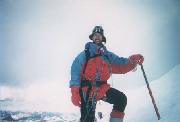

Mt.Robson National Park
British Columbia, Canada
In summer 1997 my climbing mate Rick invited me to come over to
America, to do some alpine climbing in the Rockies. As the big climb
of our trip we decided to go for the Kain face at Mt.Robson. Robson is the
highest peak in the Canadian Rockies and a 'dreamgoal' for every alpine
climber. Unfortunately the weather gods were deciding against us. As we
reached our second camp at the 'Extinguisher Tower' at the edge of the
Robson glacier, a huge thunderstorm was rushing in and it was raining
during the whole night. The snow and ice conditions were pretty bad, it
was simply too warm and the snow was slushy up to an altitude of more than
3000m. To reach the high camp at Robson - the socalled 'Dome' - you can
choose between traversing along a snow ridge or doing a shortcut and climb
an icefall called the 'Mousetrap'. The rangers already advised us not to
try the Mousetrap cause it's very unstable right now and an avalanche
killed two climbers there some days ago. But we've had decided for the
ridge anyway. On the second day we met an american party who turned back
at the ridge cause it was too dangerous! It is steep and very deep
snow they told us. And as the weather turned bad at the campsite we knew
it, that's it for the Kain Face!
Fortunately there is a much easier but nevertheless beautiful mountain
nearby,
Resplendent Mountain (3400m). It was first climbed by a canadian party led
by the Austrian Konrad Kain in 1911. Two years later he went on to lead
another party to the top of Mt.Robson, having chopped hundreds of steps
into the iceface nowadays known as the Kain face. To reach the ridge of
Resplendent Mt. we followed the Robson glacier up to the Resplendent
Couloir, where you either turn to the left to climb Resplendent or right
to travers to the Dome. On the way to Resplendent you also have to cross
the lower part of the
Mousetrap icefall. During our ascent the strom was still raging
but it had stopped raining at least. The visibility was terrible but we
could follow the tracks of a canadian party, who
climbed the mountain the day before. Without those tracks I'm pretty sure
we wouldn't have made it. Some pictures are misleading because they were
taken when the visibility was exceptional good! After the
couloir beware of
hidden crevasses on the ridge. Rick 'found' one during descent. Luckily he
was able to stop his fall by spreading his legs and pounding his crampons
into the sides of the crevasse. He still fell into it up to his armpits.
Suddenly only his head was visible. After he climbed out I carefully
peered into the hole and saw that it widened until you could't see the
sides
anymore, so it was a pretty big thing. On the final part the summitridge
becomes narrower and you have to look to avoid the cornices.